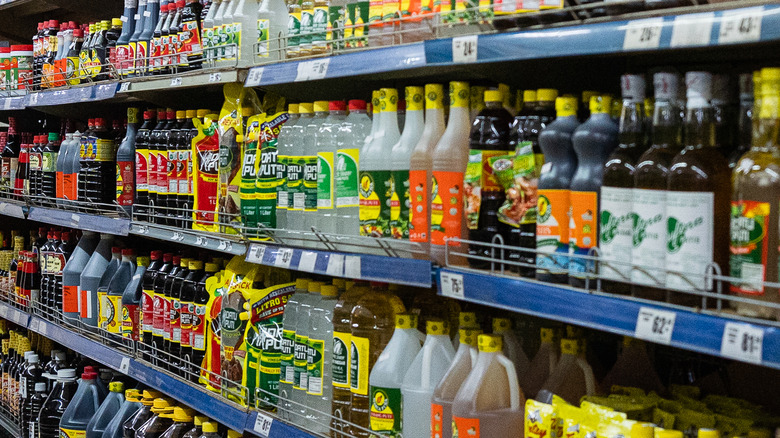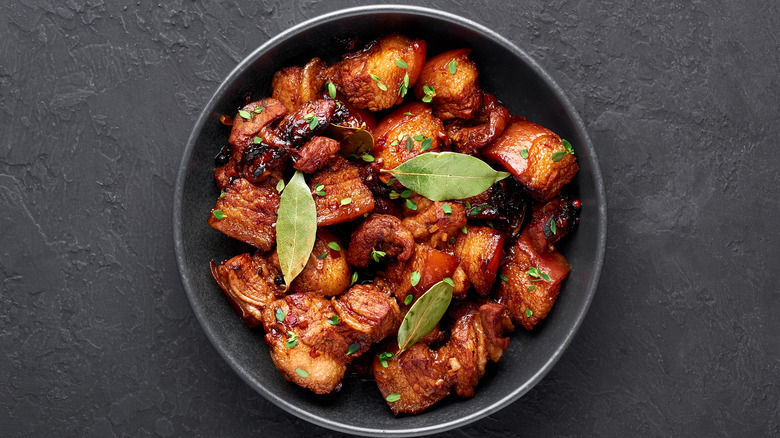Filipino Vinegar Is The Pantry Staple You Didn't Know You Needed
Balsamic, white wine, rice, apple cider, and malt are some of the kinds of vinegar that are commonly labeled as pantry essentials. They work wonderfully in marinades, for pickling vegetables, and enhance the vibrant tastes in salads. Into cakes, on top of fries, and even used for cleansing cloudy drinking glasses, vinegar, in many ways, makes the culinary world go round. Before you assume that your pantry is fully stocked with all the varieties of vinegar you could need, there is one that might be missing: sugarcane vinegar.
White cane vinegar, sukang maasim, and fermented cane vinegar, sukang Iloco, are Filipino staples added to many incredible dishes and dips to make delightful flavors sing. Filipino food usually revolves around three key tastes: sweet, salty, and sour. Sour, being the forefront taste in many ways, is produced from sour fruits like calamansi limes or with the addition of this unique vinegar. It's a truly remarkable ingredient that needs to be on the top shelf of the pantry, especially if you want to make some cracking Filipino cuisine.
Make room in your pantry
While there are various kinds of vinegar in the Philippines (including coconut and palm), fermented cane vinegar is among the most popular. Sukang maasim and sukang Iloco are the most common and can be bought in Asian supermarkets across the U.S. under the brand Datu Puti. Sukang maasim is white cane vinegar with a mild, sour taste. It's most commonly used in general cooking, for pickling, marinating, and seasoning.
Sukang Iloco, originating from the Ilocos region in the northwest of the Philippines, is made from an Ilocano wine called basi. Basi is made from sugarcane molasses, but to become vinegar, the wine is left to sour and ferment. It usually has a yellowy-dark brown and cloudy appearance which sets it apart from many other vinegars. It's much sweeter than sukang maasim but retains a good sour balance. The sweetness is marvelous as it can beautifully tenderize meat, but it can equally be enjoyed when whipped up into a dipping sauce.
How to use it
Given all you've learned about these two wonderful types of vinegar, it's time to put them to use. Perhaps the most iconic Filipino dish, adobo, is the best place to start. Marinate pork, chicken, or seafood in soy sauce, garlic, white cane vinegar, and black peppercorns for at least an hour. When the infusion is complete, boil the marinade and meat with the addition of water and bay leaves. After an hour, you'll want to transfer this to a roasting pan and place it under a broiler to caramelize. There's some debate about when to add the vinegar, whether during marination or before broiling. There is no definitive answer, as there are countless adobo recipe variations across the numerous islands throughout the Philippines.
Another way to use sukang maasim comes from chef Leah Cohen. As documented by Saveur, she uses a spiced version of the condiment to accent ukoy, fritters chock full of small (typically unshelled) shrimp, sweet potato, and chives.
To try sukang Iloco, you can always boil it down with a little sugar to create a thicker consistency akin to balsamic glaze. This sharp yet delicious sweetness will work incredibly well on fruit or drizzled over a salad.
Those are just a few ways to implement both kinds of cane vinegar, so why not keep experimenting? It's a diamond in the rough amongst a sea of ferments you can now confidently say you know how to use.


